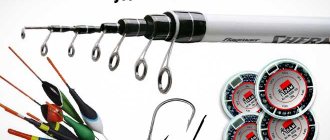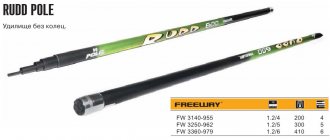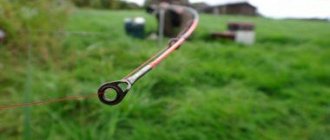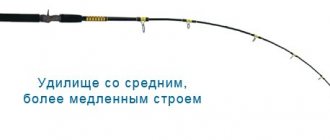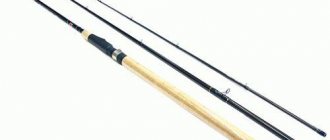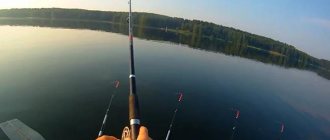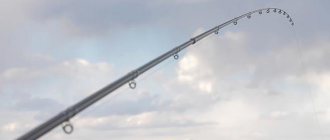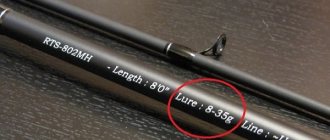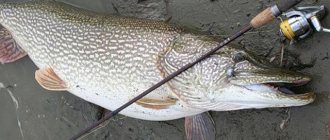A fly rod is familiar to every fisherman, because it was with this type of tackle that the vast majority of fishing enthusiasts began their hobby. The prototype of the modern fishing rod was an ordinary wooden rod, which, through its length, effectively helped a person to deliver bait to places where fish accumulated, thus helping to increase the effectiveness of hunting. Over time, the wooden whip was transformed into a high-tech product made from lighter, more elastic and durable materials, which increased both the reliability of fishing and the comfort of using the fishing tool.
Despite the emergence of new fishing directions and varieties of float gear, fishing with a fly rod does not lose its relevance today, and under certain conditions it becomes the only option for high-quality and convenient fishing at short distances, which is successfully used not only by amateur fishermen, but also professionals in the field of fishing sports. The fly rod equipment, which is not overloaded with elements, allows for high-speed fishing, and the simple and understandable installation design is suitable for any novice fisherman. The following information will be presented to the reader about fishing with a fly rod, the structural features of this type of tackle and the best models of fishing rods in this direction.
What is a fly rod
The fly rod is rightfully considered the classic, most popular, and indeed the most common fishing tool among anglers. Just three, four decades ago, bamboo composite rods overwhelmingly covered any float fishing conditions. Today, these outdated tackles have been replaced by lighter plastic telescopic fishing rods, which are compact and relatively affordable in price.
Fly fishing rods do not have guide rings in their designs. To a large extent, their form is not modified by any other elements, in rare cases it stands out only by the presence of a comfortable grooved handle on the butt of the product, which helps to improve the grip of the tackle for the fisherman. A blind float rig is attached to the quivertip of the fishing rod, not exceeding the length of the rod itself.
Important! The main purpose of the fly tackle is to quickly catch small fish at short fishing distances.
Features, advantages and disadvantages
Fly rods are distinguished by the simplicity of their design, and therefore do not cause technical difficulties in fishing. On rods of this type there are no unnecessary or secondary elements; each piece of equipment plays an equally important role. Due to its rational design, the swing has a number of undeniable advantages over other types of float gear.
- The low weight of the fishing rod facilitates dynamic fishing, which does not tire the angler so much compared to using gear of the same length, but of different directions and structure.
- High sensitivity of the gear and the ability to use thinner lines. After all, the absence of guide rings eliminates the frictional forces that arise during fishing, and therefore does not deform small-diameter threads.
- High fishing speed due to increased hooking efficiency and precision and clarity of control of the fly rod.
- The equipment for a fly rod can be quickly replaced with another, pre-prepared option that suits changing fishing conditions.
- The cheapness and prevalence of installation elements, as well as the simple fishing technique itself.
In addition to the advantages, it is worth dwelling on a number of disadvantages that may affect the choice of gear depending on the expected conditions of the planned fishing session.
- Short fishing distance without the possibility of increasing it.
- Fishing depth limitation. After all, the strictly limited maximum length of the equipment does not allow the use of sliding installations.
- Assembling gear takes more time than fishing tools with a reel.
- Catching large and medium-sized fish will require the mandatory presence of a landing net, since fishing with blind equipment is technically quite difficult.
Selection and installation of gear
The rod consists of a blank divided into segments. The smaller the number of sections, the lighter the weight of the fishing gear. The main quality criterion, which also affects the weight, is the material. The best models are made from carbon fiber, a durable and ultra-light raw material; many manufacturers use fiberglass and composite (a hybrid obtained by using several elements). One of the most famous is the Mikado company. The next parameter is length. First of all, the growth of the fishing rod depends on the fishing location: if the edge is close to the shore, you need to start fishing here, since underwater inhabitants prefer to stick to such bottom irregularities. An excellent solution would be a plug-in model, in which one or two elbows can be removed if necessary. As a rule, they are produced up to 11 m long.
Advantages of fly fishing:
- minimum weight of the rod that even a child can handle;
- instant replacement of equipment if ready-made installations are available;
- quick research of both coastal and distant fishing zones;
- accurate and silent casting to the baited area;
- functionality and wide range of applications;
- constant contact between the angler and the rod.
Read How to tie a float to a fishing line in various ways
Fishing with a fly rod does not involve the use of reels. The fishing line is attached to a special device - a rod connector. It is structurally reminiscent of a small bushing, which is glued into the whip (if a shock absorber is not used) and has a hook for the loop. Ready-made leashes with various options for loading and equipment are convenient to store and transport in leash holders; some fishermen use small reels. In the event of a break, the installation can be re-equipped in a matter of minutes. The diameter of the fishing line depends on the size of the intended trophy and hook. Fishing rod floats are sliding floats, with a long guide tube for catching small fish and a high antenna for long distances and deep places. Shot weights are placed along the entire length of the leash. Proper loading increases the sensitivity of the tackle and distributes the test weight of the float among themselves.
Installation Tips
Fishing in still waters is characteristically different from fishing in flowing waters. On a pond, an angler can use small weights that would be easily pulled by the current on a river. The fly rod is used in both situations; only the equipment is adjusted. The thickness of the leader when fishing with a retrieve is significantly reduced, since the fish is in direct contact with the line and feels the roughness. The installation can be equipped with an additional hook, so different depths can be fished with one wire. The float is used in a sports class, with a test weight of up to 2 g. It is attached using tubes placed on the keel and a small ring built into the body.
The shape depends on the fishing method - when searching for fish, elongated models are used for fishing, and for stationary fishing you will need a streamlined spherical alarm. Fishing in still water does not require such delicacy. The main weight is placed at the bottom, at a distance of 5 cm from the hook, so the fish does not feel the line. Blind equipment is more popular than sliding equipment. The connector for the fishing rod is selected according to the size of the cavity of the whip, it should fit closely into it.
How to choose a fly rod
A fly rod has a number of basic performance characteristics and parameters that seriously affect fishing. Based on these values, the fisherman selects the optimal gear values for certain fishing conditions, based on the distance of bait supply and the size of the expected trophy in the catch. Properly selected gear parameters make fishing with a fly rod comfortable and accurate in casting, as well as reliable when hooking and landing caught fish, which ultimately affects the overall fishing result.
In continuation of the article, we will consider the main operating ranges of parameters and characteristics of fly fishing rods in more detail, paying attention to the values of specific numerical values of the form and the material of its manufacture.
Form length
The float fishing rod for swinging has a fairly wide range in its length parameters. Tackle forms vary in size, ranging from one and a half meters to a length of eleven meters. Based on fishing practice, for the convenience of selecting equipment, experts divided the length ranges into groups, thereby highlighting their main purpose.
Tackle lengths in the range of 1.5-5 meters are most suitable for catching small fish from a floating craft. Such a fishing rod covers the conditions for hunting at a short distance of active fish collected on a bait spot. Lightweight fishing rods provide high-speed fishing with precise delivery of bait to a specific point.
The range size of 5–7 meters is classified as a universal and most common category of fishing rods. With this gear you can safely catch medium-sized fish, up to 3 kg. The fishing rod works ideally in stagnant and weakly flowing reservoirs when fishing both clean and algae-covered water areas.
The length of a fishing rod of 7–9 meters is less common and is used in conditions that ensure the production of fish on long casts. Using the gear will require preliminary training in the techniques of using a fishing rod to accurately deliver the bait. Fishing also requires gaining skill. If it is possible to replace the tackle with another type, it is best for a novice fisherman to take advantage of this situation by changing the swing to a more practical bologna in these conditions.
The range of 9–11 meters is considered a purely sporting version of fly tackle, and rods of this length are used only by professionals in specific fishing conditions, which requires both experience and perfect mastery of the tackle, developed through practice.
Test
The blank test determines the permissible weight of the equipment used. As a rule, this is a certain range of values that defines the upper and lower limits of the load, expressed in grams.
Important! In fishing rods used for fly fishing, the test values are necessarily indicated in the markings on the form of the product and upon purchase they are quite easy to find in the form of a record on the butt itself or on the second leg of the telescopic rod.
Based on this test, the angler can determine the optimal weight of the equipment, including the weight of the float and the bait used, the use of which eliminates overload, and, consequently, breakage and damage to the fishing rod blank. For this type of equipment, there is an unspoken rule that even the most renowned manufacturers of fishing products adhere to, setting the lower limit of the test to be no less than the number that determines the length of the fishing rod in meters. Accordingly, the lower test of a five-meter whip will not be lower than five grams, and a seven-meter one - seven.
Material of manufacture
First of all, the material of the product affects the weight of the equipment. The smaller the mass of the fishing tool, the more comfortable the fishing and the lower the degree of fatigue of the fisherman. The lightest and best fly rods are made from graphite, but such equipment is very expensive and needs to be treated with care, being fragile and unable to withstand any shock loads.
Graphite tools are used in sport fishing with a professional approach to the art of fishing. A wide range of telescopic fishing rods for amateur fishing are made from fiberglass, carbon fiber and composite alloy. Fiberglass is the cheapest, but at the same time the heaviest material. This tool is recommended for beginner fishermen to gain practice and skill in fishing. Carbon fiber and composite gear are much more expensive than fiberglass, but at the same time they are more flexible and lightweight. For example, a six-meter carbon fiber fishing rod weighs only 250 grams, with a butt diameter not exceeding 4 cm. Fiberglass fishing tackle of the same length weighs at least twice as much and has a base thickness of at least 5 cm.
Build
The structure of fly rods characterizes the degree of flexibility of the tool. Manufacturers produce blanks with fast, semi-fast and medium action. To a lesser extent, you can find a fishing rod with a slow action, in which the entire blank bends during operation.
Important! In the swing, the medium action is considered universal. This fishing rod is suitable for most fishing conditions.
Hard tips are used for catching small fish that need to be quickly hooked, but there is no need to land them at all. It’s easier to catch medium-sized fish, and in most cases large ones, with medium-sized gear. The slow action does not allow for clear detection of medium and small fish, and the specific use of such equipment depends on the type of fish being caught, which must swallow the bait and thus self-identify. A striking example is the perch, which quickly sucks up the bait, but has delicate lips that inexperienced fishermen tear with hard tackle as a result of aggressive hooking and the same fishing.
Blind rig for fly rod
The blind rig option is more convenient than the sliding rig, which is why it is very popular
In this case, it is important to pay due attention to the choice of the shape of the float, guided by the principle: the faster the flow, the more streamlined and rounded the float should be
This is due to the technology of hold fishing, when the angler supposedly specially stops the float so that the current moves the hook a little forward. If the float has a slightly elongated body, under the influence of water it will jump out or turn over on its side.
To attach a blind leash, you should use 3 tubes on the keel, with the lower half being put on partially. One tube is a spare and is used in case one of them becomes unusable. A small metal eye in the upper part is used to pass the fishing line through.
It is customary to use heavy olives as shipping for blind equipment, which ensures that the equipment is quickly immersed in the desired area of the reservoir. And in order to protect the equipped fishing line from the effects of the current, it is necessary to use a backup of several pellets.
When fishing in still water or rivers where there is no current, the pellets are placed at a great distance from the main load and the leash with bait.
In order to fish the chosen place as efficiently as possible, the load of pellets is placed on the line evenly, and each subsequent pellet should be lighter.
If you understand the basic aspects of the work of shipping, and also learn how to use them correctly, this will significantly increase the chances of a good bite.
The diameter of the fishing line is determined taking into account:
- Fishing places.
- Estimated production size.
- Required casting distance.
If heavy equipment is used, then the section of the fishing line must be appropriate. In this case, the leash is always thinner.
Equipment elements
In addition to the form itself, to assemble a fly rod you will need a number of elements assembled into a general assembly for certain fishing conditions. The basis for installation is nylon fishing line. In rare exceptions, fishing lines are used with a thickness of over 0.2 mm, and the most popular diameters are considered to be in the range of 0.15-0.18 mm. Floats for fly fishing rods are most convenient with a blind type of fastening, which can be easily achieved for connecting to a fishing line by using a nipple rubber equal to the thickness of the antenna and keel of the accessory. Along with a stationary pellet sinker, it is possible to use a sliding sinker, limited in movement by stoppers. Equipment will require hooks, the size and shape of which will depend on the type of bait used.
For more delicate rigs, leashes made of monofilament fishing line are used, an order of magnitude smaller in diameter than the base. The installation may also include a feeder, to which the main fishing line will be attached. To attach a fishing line or feeder to a quiver tip, you will need a connector, the diameter of which must correspond to the diameter of the rod tip. The presence of several small reels will allow you to store and quickly change equipment prepared in advance at home to suit the changed parameters of the ongoing fishing session.
Equipment
The fly rod equipment consists of the following elements:
- main line;
- float;
- series of lead crushers;
- a leash made of thin fishing line;
- hook.
The fishing line is attached to the end of the rod using a special connector; in expensive models this element is already provided. If the product is designed to catch large carp, then at the end there should be a shock absorber made of soft rubber.
When fly fishing is carried out, sinkers should be evenly distributed throughout the gear, especially in areas that will be under water. The float here is used in the form of a drop if fishing is carried out in a still body of water, and a reverse drop when fishing in a current.
The thickness of the fishing line is chosen to be small - about 0.12-0.14 mm. Beginner fishermen are better off using a thicker fishing line - about 0.16-0.18 mm. When fishing in large bodies of water, there is a chance that a fish weighing about 2-3 kg will bite, so here you need to install a fishing line with an even larger diameter - 0.17-0.22 mm.
It is advisable to use a leash made of thinner fishing line so that the fish cannot notice it. Fly fishing involves fishing simultaneously with several leashes, the maximum length of which should not exceed 30 cm. Swivels are not provided in the fly fishing tackle; the leashes are secured using the loop-to-loop method.
fishing line
Flying rod equipment
I advise experienced fishermen to adhere to the following data:
- When hunting for large fish, stock up on strong fishing line with an approximate thickness of 0.35 mm.
- When fishing for fish over 6 kilograms, you must choose a fishing line with a thickness of more than 0.35 mm.
- When hunting for smaller fish, a fishing line of 0.20-0.25 mm and a leash of 0.12-0.15 mm are suitable.
Excellent transparent fishing lines are made from fluorocarbon material.
Float
The float for the fly fishing rod is selected based on the depth and wind strength. When fishing at a depth of up to 1.5 meters and calm water, you need a float with a weight of 1.5-2 grams. And in the case of great depths and strong winds, you will need a float with a weight of up to 3 grams.
Installation of equipment
For proper installation of equipment, adhere to the following plan:
- Classic-lightweight. It comes in medium and long lengths (from 5 to 11 meters) and is intended for catching small and medium-sized fish.
- Bleak-lightweight. This species has the shortest length (from 1 to 4 meters) and is suitable for catching small fish.
- Carp-weighted. It comes in medium and long lengths (from 7 to 14 meters). Based on the name, it is clear that this species is intended for catching carp of similar sizes.
How to rig a fly rod
The purchased fishing tool is modified by gluing a connector for a fly rod onto the tip of the quiver tip. Next, take a piece of the main fishing line that is equal to, with further use of the leash, or 20 cm longer than the length of the rod itself. At the end of the line cut, a tightening loop is made, through which the equipment will be attached to the connector. If a feeder is used in the installation, then loops are installed at both ends for connection to the connector and the main line.
A float is attached to the fishing line using nipple rubber bands or using stoppers for a sliding type of alarm. Following the float, a weight is placed, distributing it along the length of the fishing line to the leash or hook.
At the end of the installation, a hook is tied to the fishing line or leader material. After adjusting the operation of the float, setting its depth, and installing the bait, the fly rod is completely ready for use.
What is a fly rod
Without knowing what a fly rod is, you can make a mistake when choosing a design. It is a telescopic bank without access rings. The peculiarity is that it is thrown over the head in a wide swing.
This fishing rod is made from either fiberglass or carbon fiber. Has the following characteristics:
- ease;
- convenience;
- strength;
- the ability to place it on a special stand when there is no bite;
- does not slip out of your hands.
Fly fishing rods can be of different sizes and are designed for fish of any weight. The main criteria for selection are:
- Corresponding to the place of fishing. First of all, this concerns the linear dimensions of the reservoir. If the fly rods are too long, then their use will be impractical when fishing on small ponds. In this case, you will have to carry with you many rods of different lengths.
- Line length and fishing rod size. If the rod is too large, it will simply be inconvenient for comfortable use. Because of this, the fishing line will have to be reeled in, which means there will be too much of it, it will begin to tangle and tear. In addition, hooking a fish in this state will be much more difficult.
Fishing with a fly rod in spring or summer is considered an easy process, but still has some nuances. For example, it is not recommended to hold the rod a little higher while trying to position the float at the desired distance. This way your hands will get tired quickly. In addition, if the weather is windy, the float along with the fishing rod will be blown to the side. Therefore, it is recommended to have several rods of different lengths in your arsenal when fishing at different distances:
Read How to tie a fishing line to a fishing rod without guides using different methods- on the near one - 3 m;
- on average - up to 6 m;
- at long range - up to 9 m.
Rating top 5 best
To select decent gear, we will present the angler with a rating of fly fishing rods, which gives a guide to a high-quality purchase that can last a long time.
- Our top 5 in first place will be opened by the fishing tool Black Hole River Hunter . This is a budget, but high-quality model of a lightweight fishing rod with a fast action. Suitable for catching small and medium-sized fish. It is recommended for novice fishermen as a reliable and forgiving tackle during the learning process.
- Second line for Shimano Catana BX TE 2–500 . A well-known brand guarantees a high-quality and lightweight carbon blank. With this equipment you can confidently catch even large fish without worrying about its strength. The cost of the fishing rod is in the average price level.
- Third place goes to the brainchild of the Daiwa brand, the Powermesh model . Made of carbon, the fairly lightweight tool has rigid parameters, which allows you to reliably detect fish and accurately deliver the bait even in cramped fishing conditions. The cost of the product is close to the budget option.
- Milo Relix 2000 received fourth place only for its high cost. Otherwise, this thin and miniature rod has no flaws. It is perfectly balanced and when working with such gear there are no problems when hooking and landing medium-sized fish.
- The budget Tica Triumph Carbon . A carbon blank with a flexible, fast-acting whip is slightly overweight, but has a high degree of resistance to shock loads. A line of different-sized blanks allows you to cover almost any fishing conditions. When selling a product, the manufacturer accompanies the purchase with a warranty confirming the reliable operation of the product throughout the year.
